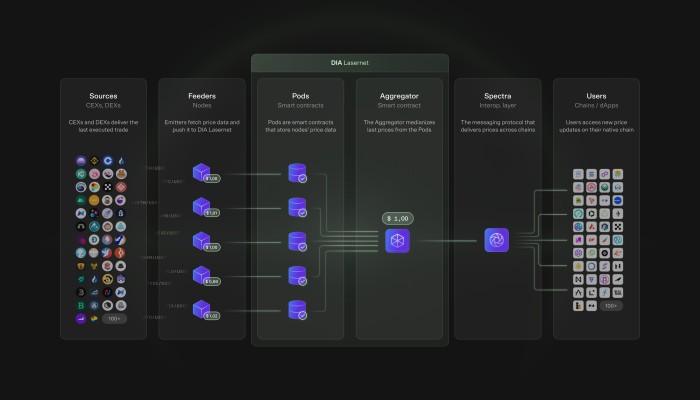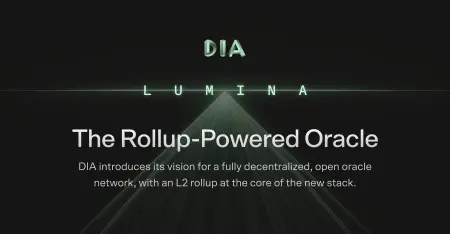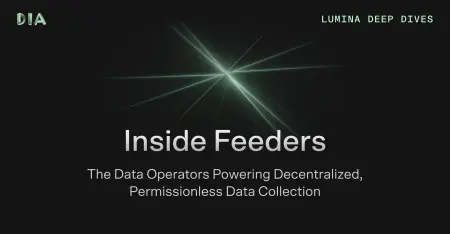Inside Lasernet: the L2 Rollup Powering Trustless Oracles
Explore how Lasernet, a Layer-2 rollup network at the heart of DIA’s Lumina oracle stack, delivers a trustless, decentralized, and scalable environment for oracle operations.

This post is the first in of a series diving into the components of Lumina, DIA’s new rollup-based, trustless oracle stack.
TL;DR
- ‘Lasernet’, DIA’s native Layer-2 rollup brings trustless computation, decentralization and verifiability to oracles
- Lasernet can infinitely scale due to its modular design (separating consensus, execution and DA) while inheriting the security of Ethereum.
- Staking, fraud-proofs and slashing mechanisms ensure the network’s security in a decentralized and trustless manner.
- Network fees on Lasernet are cost-efficient due to transaction batching and compression. The DIA token will function as the network’s gas token.
- Lasernet testnet will go live in Q4 24. After a testing period, mainnet will be deployed in Q1 25 with a limited number of participants. After sufficient testing the network will be opened within 2025–
Introduction
What is Lasernet?
Lasernet is a Layer-2 rollup that serves as the core of the Lumina oracle stack. It provides a fully trustless, decentralized, and verifiable environment for all oracle operations such as data aggregation, filtering, computation, and more. By leveraging optimistic rollup architecture and a modular design, Lasernet enables these operations to happen on-chain in a cost-efficient manner.

Why an Oracle Rollup chain?
Oracles act as the software pieces that connect off-chain data and on-chain applications and are required to enable more complex and useful applications such as lending and borrowing. Trustlessness and verifiability are critical for dApps consuming the data. Executing all oracle operations on-chain ensures that the data that dApps consume is as secure as possible.
Lasernet addresses these needs through decentralization, trustlessness, verifiability and modularity.
- Decentralization: Establishing a network of independent nodes that source and feed first-party data directly from exchanges into the chain, eliminating single points of failure.
- Trustlessness: Ensuring that data aggregation, processing, and the creation of final data points happen entirely on-chain and without reliance on centralized intermediaries.
- Verifiability: Allowing anyone to trace and audit all data easily flows within the network, promoting transparency and accountability.
- Modularity: With an architecture that scales as it grows and can integrate new components enabling continuous innovation and scalability.
Lasernet leverages state-of-the-art blockchain innovations, such as optimistic rollup architecture or data availability layers. This provides scalability without compromising security, relying on Ethereum’s robust security model for finality.
Long-Term Vision of Lasernet
Lasernet aims to revolutionize the oracle landscape by:
- Enabling open participation: Transitioning into a fully open and permissionless network where anyone can source and feed data, deploy custom oracle smart contracts, powered by a sustainable tokenomic model.
- Becoming an open data chain for Web3: Serving as a comprehensive repository for diverse data methodologies, unlocking new possibilities for data sharing and utilization across any chain.
- Achieving endless scalability: Utilizing modularity and decentralization to provide a trustless data solution capable of scaling with the growing demands of Web3 applications.
Modular Design and Decentralization
Modular Blockchain Design
Lasernet is designed as an optimistic rollup and its modular architecture is a cornerstone of its scalability and efficiency:
- Separation of layers:
- Execution layer: Handles the processing of transactions and smart contracts.
- Consensus layer: Manages the agreement on the state of the network.
- Data availability layer: Ensures that transaction data is accessible to all participants without burdening the execution layer.
- Benefits of separation:
- Scalability: Each layer can scale independently, allowing for targeted optimizations.
- Flexibility: New technologies can be integrated into specific layers without affecting the entire system.
Reduced congestion: Offloading data storage and availability reduces the load on both Lasernet’s execution layer and Ethereum’s Layer 1.

Flexibility Through Modularity
Keeping the design of Lumina and Lasernet modular offers a few key advantages:
- Component upgradability:
- New technologies and improvements can be integrated into specific layers without disrupting the entire network.
- Supports the addition of features like ZK co-processors to enhance privacy and efficiency or new cross-chain communication primitives to provide flexible interoperability
- Potentially, Lasernet itself could be replaced by another chain e.g. a Layer-3 rollup
- Innovation adoption:
- The architecture is designed to embrace advancements in blockchain technology.
- Ensures that Lasernet and the Lumina oracle stack remain at the forefront of the industry.

Architecture and Design
Let’s take a closer look at how data is managed on the chain.
Transaction Flow
The lifecycle of data within Lasernet involves several key stages:
- Data sourcing and submission
- Feeders (independent nodes) collect raw data from various on-chain and off-chain sources, such as financial markets, APIs, or DePIN solutions.
- On-chain submission: Feeders submit transactions containing this data to Lasernet’s Layer-2 network.
- On-chain processing
- Oracle operations: Data gets aggregated, validated and processed on-chain within smart contracts, ensuring trustlessness.
- Final data point creation: The processed data is compiled into final, usable data points for decentralized applications.
- Batching and compression
- Transaction batching: Oracle transactions are grouped to optimize network efficiency.
- Data compression: Reduces the size of transaction data, enabling more efficient storage and transmission.
- Data availability
- Submission to DA layer: Blobs are submitted to the Data Availability layer, ensuring that transaction data is accessible without facing L1 scalability issues.
- Separation of concerns: Execution and data availability are handled independently, enhancing scalability.
- Commitment to Layer 1
- Anchoring on Ethereum: Compressed transaction batches are periodically committed to the Ethereum blockchain, inheriting its security guarantees.
- Verifiability: Provides an immutable record of transactions that can be audited and verified by anyone.

Optimistic Verification
Lasernet utilizes an optimistic rollup as part of its core functionality:
- Assumption of validity:
- Transactions are presumed valid upon submission, allowing for rapid processing and confirmation.
- Challenge period:
- A defined timeframe of 1 week during which any network participant can challenge the validity of a transaction.
- Balances speed and security by enabling swift processing while providing a window for dispute resolution.
- Fraud proofs:
- If a transaction is suspected to be invalid, a fraud-proof can be submitted.
- The network verifies the fraud-proof, and if confirmed, the invalid transaction is reverted.
- Penalties for malicious actors:
- Participants submitting fraudulent transactions may face penalties, such as slashing of staked tokens, and deterring malicious behavior.

Batching and Compression
To optimize performance and reduce costs, Lasernet leverages the following 3 methods:
- Transaction batching:
- Groups multiple oracle data transactions into single batches, reducing the number of interactions with Layer 1.
- Improves efficiency and decreases per-transaction fees.
- Data compression:
- Utilization of large data blobs:
- Uses sizable data units, just under 2 MiB (1,973,786 bytes), to post extensive data efficiently
- Achieves higher transactions per second (TPS) and reduces costs for data-intensive operations.
- Low transaction costs:
- Optimized transaction processing results in significantly reduced gas fees.
- Makes it economically feasible to perform frequent oracle updates and data feeds.

Gas token and fees
The DIA token is central to the Lasernet’s functionality:
- $DIA as gas token:
- Lasernet uses the $DIA token as its native gas token for processing transactions within the Lasernet and Lumina oracle stack.
- Aligns the economic incentives of network participants with the utility of the DIA ecosystem.
- Open market-based fee structure:
- Transaction costs are determined by the demand for block space on the rollup.
- Fees adjust dynamically based on network congestion, promoting fair access and efficient resource utilization.
- Incentivization mechanisms:
- Validators, Feeders, and other participants are rewarded with DIA tokens.
- Encourages active participation and contributes to network security and reliability.
EVM Compatibility
Lasernet’s full compatibility with the Ethereum Virtual Machine (EVM) offers significant advantages:
- Supports standard development tools such as Solidity, Remix, Hardhat, and Truffle.
- Reduces the learning curve and accelerates development cycles.
Data Availability Layer (DA)
How the DA Layer Works
- Data publication:
- Transaction batches are published to the DA layer, making them publicly accessible for verification.
- Ensures transparency and trustlessness in data handling.
- Data availability sampling:
- Nodes perform sampling techniques to verify that data is indeed available.
- Protects against data withholding attacks and maintains network integrity.
- Security guarantees:
- The DA layer enhances security by providing a reliable method for data verification.
- Supports the optimistic rollup’s need for accessible data during the challenge period.
- Data verification:
- External actors can verify data through block explorers and monitoring tools of the L1, Lasernet and the DA.
- Transparency mechanisms enable community oversight.
Scalability and Throughput Gains
- High transactions per second (TPS):
- By efficiently batching and compressing transactions, Lasernet aims for TPS in the thousands.
- Significantly surpasses the limitations of Ethereum’s current TPS capabilities.
- Lasernet’s DA blobs can have up to 1.8mb of data which is enough for around 45k transactions.
- Optimized resource utilization:
- The modular design ensures that increased throughput does not proportionally increase resource consumption.
- Promotes sustainable growth as network usage expands.
- The DA layer ensures data is readily available without burdening the execution layer.
- Enhances performance by allowing the execution layer to focus on transaction processing.
Security and Fraud Proofs
Security Model of Optimistic Rollups
Lasernet’s security framework is integral to its role within the Lumina oracle stack:
- Inherited security from Ethereum:
- By anchoring transactions to Ethereum’s Layer 1, Lasernet benefits from its robust security model.
- Leverages Ethereum’s consensus mechanisms and finality for transaction validation.
- Decentralized dispute resolution:
- Open participation: Any participant can challenge transactions, promoting decentralization.
- Fraud Proof Verification: The network validates fraud proofs to ensure only valid transactions are finalized.
- Challenge period dynamics:
- Provides a window of 7 days for disputes without significantly delaying transaction finality.
- Balances efficiency and security to maintain network reliability.
Penalties and Incentives
- Slashing mechanisms:
- Malicious actors face penalties, such as losing staked $DIA tokens.
- Deters fraudulent behavior and encourages honesty among participants.
- Reward structures:
- Honest participants may receive rewards for identifying and proving fraudulent transactions.
- Aligns individual incentives with the overall security of the network.
Decentralization Roadmap
Lasernet will launch in phases before transitioning to a fully open network.
-
- Testnet launch – Q4 2024 (permissioned)
- Establish stability and security, allowing for optimization of core functionalities.
-
- Developers can get familiar with the network and provide feedback.
- Anyone can deploy custom oracle smart contracts; data can only be used in test environments.
- A set of Feeders contributes to the network’s data sourcing and security.
- Pre-staking: DIA holders can stake DIA early.
- Mainnet launch – Q1 2025 (permissioned)
- The network is production-ready.
- Anyone can deploy custom oracle contracts, and use data in productive environments.
- A set of Feeders contributes to the network’s data sourcing and security.
- Staking: DIA holders can stake tokens to secure the network
- Open mainnet – 2025 (permissionless)
- Lasernet will evolve into a fully open network where anyone can run nodes, feed data, and use data freely.
- Open feeders + staking: Anyone can run a node and/or delegate to an existing Feeder
- Enhances decentralization and community participation.








